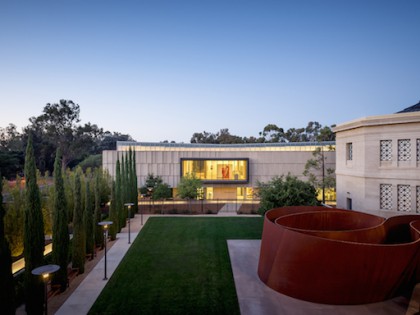Contrary to popular belief, Stanford isn’t strictly a Silicon Valley trade school for Internet billionaires. It also trains Internet millionaires—as well as, believe it or not, thousandaire philosophers, journalists, and artists! Because aside from computer science and electrical engineering, Stanford offers degrees in a full range of humanities disciplines, including the fine arts. To that end, two months ago the university opened a small, glowing new museum to house a significant modern-art collection donated by a local family who, to further confound your preconceptions, made its fortune not in tech but food service. If your college campus meals were supplied by Saga Corp., you can take comfort in knowing that, whatever you thought of the fajitas or salad bar, some of the profits were spent on undeniably great works by Mark Rothko, Jackson Pollock, Louise Nevelson, Robert Motherwell, and Frank Stella.
The museum, with 121 paintings, sculptures, and other artworks, is formally known as the Anderson Collection at Stanford University. The benefactors are Harry W. and Mary Margaret Anderson and their daughter, Mary Patricia Anderson Pence—or Hunk, Moo, and Putter, the nicknames by which they are referred to in the museum’s catalog. Back in the 1980s, when I was an undergrad at Stanford taking a stray art-history class, I was fortunate enough to be able to visit the Anderson home, which isn’t far from the campus. (Saga itself was headquartered on Sand Hill Road in Menlo Park, long before it was a mecca for tech-oriented venture capitalists and cougars. The Anderson’s ranch-style house wasn’t all that big by major-fortune standards, even then—and certainly not now. (Silicon Valley homes are still relatively modest, compared to Beverly Hills or Greenwich, but that may be changing.) I remember being fascinated by the way the collection, which includes pretty much all the brand names of the 50s, 60s, and 70s, felt almost wedged into the house, with masterpieces seemingly elbow to elbow in big rooms, and large canvases lining the hallways. As a teenager, Putter had a Pollock drip painting in her bedroom; any slumber-party guests must have been very careful with their Cokes and Cheetos. (The San Francisco Chronicle estimates the painting, Lucifer, might fetch as much as $100 million at auction.)
Maybe because I was used to seeing art in generously sized museums—and still am—the intimate, close-quarters abundance of the Andersons’ home struck me then as a higher-end form of pack-rattery. Ever since, I’ve wondered what it would be like to live day in, day out with a Rothko. I still do; really, I can’t imagine a more sublime aesthetic experience. (If anyone reading this has ever owned a Rothko and gotten sick of it, please don’t tell me.)
The new two-story museum, with its big, clean, white, sunlit spaces, gives the art more breathing room. It’s an attractive but modest building, content to leave pride of place to the art; its one flourish, a graceful white staircase, which beckons you up to the second-floor galleries and would look terrific being descended by a group of dancers in top hats and tails. The art is grouped conventionally by school: abstract expressionists here, minimalists there, and so on. Moving from gallery to gallery, you can feel the Andersons developing their eyes as collectors: the abstract-expressionist work is spectacular—I was particularly taken with an Adolph Gottlieb, two Motherwells, and, happily, the red-orange Rothko I remembered from college—but there is also a sense of checking off names on a must-have list.
The choices from there become a bit less perfectly canonical. (There is no Pop Art, but that’s because the Andersons earlier donated their Warhols, Rosenquists, and Oldenburgs to the San Francisco Museum of Modern Art.) Maybe I’m biased because I grew up in Palo Alto, but my favorite gallery was the one devoted to Bay Area figurative artists such as Richard Diebenkorn (in his pre–Santa Monica incarnation), Nathan Oliveira, David Park, and Paul Wonner, artists who took the painterly brio of abstract expressionism and applied it to figure painting and landscapes. The Andersons’ Diebenkorn landscape from his Berkeley series, with its amazing tension between its surface flatness and its conjured depth, might be my favorite piece in the whole collection.
I don’t think it’s my imagination that the works here play off of one another in livelier, sometimes wittier ways than museum works often do; it feels like there’s a synergy to the entire collection, which is maybe another way of saying the collectors have an eye. The Andersons have given the public a great gift, and I hope the newer generation of local billionaires is paying attention.






